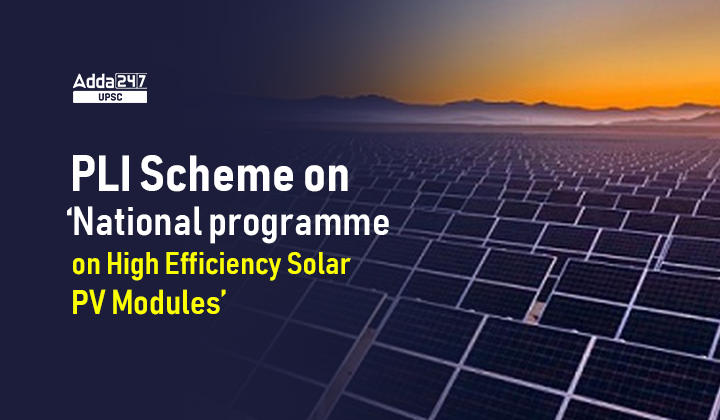Table of Contents
PLI Scheme for Solar Energy Sector- Relevance for UPSC Exam
- GS Paper 2: Governance, Administration and Challenges
- Government policies and interventions for development in various sectors and issues arising out of their design and implementation.
PLI Scheme for Solar Energy Sector in News
- Recently, the Union Cabinet, chaired by Prime Minister, Shri Narendra Modi, has approved proposal for implementation of the Production Linked Incentive Scheme (Tranche II) on ‘National programme on High Efficiency Solar PV Modules’.
- The proposal to implement PLI scheme on ‘National programme on High Efficiency Solar PV Modules’ was forwarded by the Ministry of New & Renewable Energy.
PLI Scheme on ‘National programme on High Efficiency Solar PV Modules’
- About: The national programme on High Efficiency Solar PV Modules aims to build an ecosystem for manufacturing of high efficiency solar PV modules in India.
- Associated Ministry: National programme on High Efficiency Solar PV Modules is being implemented under overall guidance and supervision of Ministry of New & Renewable Energy.
- Funding: Under it, government has provided with an outlay of Rs.19,500 crore for achieving manufacturing capacity of Giga Watt (GW) scale in High Efficiency Solar PV Modules.
- Selection Process and Tenure: Solar PV manufacturers will be selected through a transparent selection process.
- PLI will be disbursed for 5 years post commissioning of solar PV manufacturing plants on sales of high efficiency solar PV modules from the domestic market will be incentivised.
- Significance: national programme on High Efficiency Solar PV Modules will strengthen the Atamnirbhar Bharat initiative and generate employment.
- National programme on High Efficiency Solar PV Modules will help in reducing country’s import dependence in the area of Renewable Energy.
Associated Benefits/Outcomes of PLI Scheme
The outcomes/benefits expected from the scheme are as follows:
- It is estimated that about 65,000 MW per annum manufacturing capacity of fully and partially integrated, solar PV modules would be installed.
- The scheme will bring direct investment of around Rs.94,000 crore.
- Creation of manufacturing capacity for Balance of Materials like EVA, Solar glass, Backsheet, etc.
- Direct employment of about 1,95,000 and indirect employment of around 7,80,000 persons.
- Import substitution of approximately Rs.1.37 lakh crore.
- Impetus to Research and Development to achieve higher efficiencies in Solar PV Modules.
India’s Largest Floating Solar Power Project Commissioned



 TSPSC Group 1 Question Paper 2024, Downl...
TSPSC Group 1 Question Paper 2024, Downl...
 TSPSC Group 1 Answer key 2024 Out, Downl...
TSPSC Group 1 Answer key 2024 Out, Downl...
 UPSC Prelims 2024 Question Paper, Downlo...
UPSC Prelims 2024 Question Paper, Downlo...




